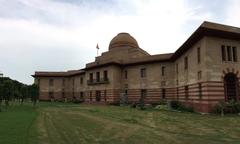Vishwa Shanti Stupa Visiting Hours, Tickets, and Historical Significance
Date: 19/07/2024
Introduction
The Vishwa Shanti Stupa, commonly known as the World Peace Pagoda, is a symbol of peace and harmony situated in Noida, India. This monumental structure stands as a testament to the teachings of Buddhism and the enduring message of non-violence. The concept of the Peace Pagoda was first envisioned by Nichidatsu Fujii, a Japanese Buddhist monk and the founder of the Nipponzan-Myōhōji order. Fujii initiated the construction of these stupas to foster global peace, with the first being erected in Hiroshima in 1947 (Nipponzan-Myōhōji). The Vishwa Shanti Stupa in Noida was inaugurated on November 13, 2007, as part of this global initiative, symbolizing a collaborative effort between the Indian government, the Nipponzan-Myōhōji order, and local Buddhist communities (Times of India). The stupa’s architectural design is a harmonious blend of traditional Buddhist elements and modern construction techniques, standing at a height of 43 meters and adorned with intricate carvings and statues depicting various aspects of Buddha’s life (ArchDaily). This guide aims to provide a comprehensive overview of the Vishwa Shanti Stupa, covering its historical and cultural significance, visitor information, travel tips, and nearby attractions.
Table of Contents
- [History of Vishwa Shanti Stupa, Noida](#history-of-vishwa-shanti-stupa-noidahistory-of-vishwa-shanti-stupa-noida)
- [Origins and Concept](#origins-and-conceptorigins-and-concept)
- [Construction and Inauguration](#construction-and-inaugurationconstruction-and-inauguration)
- [Architectural Design](#architectural-designarchitectural-design)
- [Historical Significance](#historical-significancehistorical-significance)
- [Cultural Impact](#cultural-impactcultural-impact)
- [Preservation and Maintenance](#preservation-and-maintenancepreservation-and-maintenance)
- [Role in Promoting Peace](#role-in-promoting-peacerole-in-promoting-peace)
- [Visitor Experience](#visitor-experiencevisitor-experience)
- [Educational Programs](#educational-programseducational-programs)
- [Community Engagement](#community-engagementcommunity-engagement)
- [Future Prospects](#future-prospectsfuture-prospects)
- [Visiting Hours and Tickets](#visiting-hours-and-ticketsvisiting-hours-and-tickets)
- [Nearby Attractions](#nearby-attractionsnearby-attractions)
- [Accessibility](#accessibilityaccessibility)
- [FAQ](#faqfaq)
- [Conclusion](#conclusionconclusion)
- [References](#referencesreferences)
History of Vishwa Shanti Stupa, Noida
Origins and Concept
The Vishwa Shanti Stupa, also known as the World Peace Pagoda, is a symbol of peace and harmony. The concept of the Peace Pagoda was initiated by Nichidatsu Fujii, a Japanese Buddhist monk and founder of the Nipponzan-Myōhōji order. Fujii’s vision was to promote world peace through the construction of these stupas around the globe. The first Peace Pagoda was built in Hiroshima in 1947, and since then, over 80 such structures have been erected worldwide (Nipponzan-Myōhōji).
Construction and Inauguration
The Vishwa Shanti Stupa in Noida was constructed as part of this global initiative. The project was a collaborative effort between the Indian government, the Nipponzan-Myōhōji order, and local Buddhist communities. The construction began in the early 2000s and was completed in 2007. The stupa was inaugurated on November 13, 2007, in a grand ceremony attended by dignitaries, monks, and peace activists from around the world (Times of India).
Architectural Design
The architectural design of the Vishwa Shanti Stupa is a blend of traditional Buddhist stupa elements and modern construction techniques. The stupa stands at a height of 43 meters and is adorned with intricate carvings and statues depicting various aspects of Buddha’s life. The central dome is surrounded by smaller stupas and prayer wheels, which are a common feature in Tibetan Buddhist architecture. The structure is built using white marble, symbolizing purity and peace (ArchDaily).
Historical Significance
The Vishwa Shanti Stupa holds significant historical importance as it represents the enduring message of peace and non-violence propagated by Buddhism. The stupa serves as a reminder of the teachings of Buddha, who attained enlightenment over 2,500 years ago. It also stands as a testament to the efforts of Nichidatsu Fujii and the Nipponzan-Myōhōji order in promoting global peace through the construction of these stupas (Buddhistdoor Global).
Cultural Impact
The stupa has become a cultural landmark in Noida, attracting visitors from all over the world. It serves as a center for various cultural and religious activities, including meditation sessions, peace marches, and interfaith dialogues. The stupa also hosts annual events such as Buddha Purnima and the International Day of Peace, which draw large crowds and promote the message of peace and harmony (Noida Authority).
Preservation and Maintenance
The preservation and maintenance of the Vishwa Shanti Stupa are managed by the Nipponzan-Myōhōji order in collaboration with local authorities. Regular maintenance activities include cleaning, structural inspections, and restoration of damaged elements. The stupa is also protected under the Indian government’s heritage conservation laws, ensuring its preservation for future generations (Ministry of Culture, Government of India).
Role in Promoting Peace
The Vishwa Shanti Stupa plays a crucial role in promoting peace and non-violence in the region. It serves as a venue for peace education programs, workshops, and seminars aimed at fostering a culture of peace among the youth. The stupa also collaborates with various non-governmental organizations (NGOs) and international bodies to promote peace initiatives and conflict resolution strategies (UNESCO).
Visitor Experience
Visitors to the Vishwa Shanti Stupa can experience a sense of tranquility and spiritual upliftment. The serene environment, coupled with the beautiful architecture, provides a perfect setting for meditation and reflection. Guided tours are available for visitors, offering insights into the history and significance of the stupa. The site also features a small museum showcasing artifacts and exhibits related to Buddhism and the peace movement (TripAdvisor).
Educational Programs
The stupa hosts various educational programs aimed at spreading awareness about Buddhism and the importance of peace. These programs include lectures, workshops, and interactive sessions conducted by scholars and monks. Schools and colleges often organize field trips to the stupa, providing students with an opportunity to learn about the rich cultural and historical heritage of Buddhism (Buddhist Studies).
Community Engagement
The Vishwa Shanti Stupa actively engages with the local community through various outreach programs. These programs include health camps, environmental conservation initiatives, and social welfare activities. The stupa also collaborates with local artists and craftsmen, promoting traditional arts and crafts and providing them with a platform to showcase their work (Art and Culture Trust of India).
Future Prospects
Looking ahead, the Vishwa Shanti Stupa aims to expand its role as a center for peace and cultural exchange. Plans are underway to develop additional facilities, including a meditation hall, a library, and a guesthouse for visitors. The stupa also aims to strengthen its collaboration with international peace organizations and continue its efforts in promoting global peace and harmony (Peace Pagoda Project).
Visiting Hours and Tickets
The Vishwa Shanti Stupa is open to visitors daily from 9 AM to 6 PM. There is no entrance fee, but donations are welcome to support the maintenance and various peace initiatives of the stupa. Guided tours are available and can be arranged at the entrance.
Nearby Attractions
While visiting the Vishwa Shanti Stupa, you can also explore other nearby attractions in Noida. Some notable sites include the Okhla Bird Sanctuary, the Botanical Garden, and the DLF Mall of India, which offers a variety of shopping and dining options.
Accessibility
The Vishwa Shanti Stupa is accessible to visitors with disabilities. Ramps and wheelchair-accessible pathways are available throughout the site, ensuring that everyone can enjoy the peaceful environment.
FAQ
Q: What are the visiting hours for Vishwa Shanti Stupa?
A: The Vishwa Shanti Stupa is open daily from 9 AM to 6 PM.
Q: How much are the tickets for Vishwa Shanti Stupa?
A: There is no entrance fee for visiting the stupa, but donations are welcome.
Q: Are there guided tours available?
A: Yes, guided tours are available and can be arranged at the entrance.
Q: What are some nearby attractions?
A: Nearby attractions include the Okhla Bird Sanctuary, the Botanical Garden, and the DLF Mall of India.
Conclusion
In summary, the Vishwa Shanti Stupa in Noida stands as a beacon of peace and a testament to the enduring message of Buddhism. The stupa’s rich history, architectural beauty, and cultural significance make it a must-visit destination for anyone seeking spiritual and cultural enrichment. It serves as a center for various cultural and religious activities, including meditation sessions, peace marches, and interfaith dialogues, thereby promoting a culture of peace and harmony (Buddhistdoor Global). The stupa’s ongoing efforts in promoting peace and non-violence, coupled with its educational programs and community engagement initiatives, underscore its role as a catalyst for positive change in the region and beyond (UNESCO). Whether you are a local resident or a tourist, a visit to the Vishwa Shanti Stupa offers an opportunity to experience tranquility and spiritual upliftment in a serene environment. As the stupa continues to evolve and expand its role as a center for peace and cultural exchange, it remains a testament to the universal relevance of Buddha’s teachings and the global peace movement initiated by Nichidatsu Fujii (Peace Pagoda Project).
References
- Nipponzan-Myōhōji. (n.d.). Nipponzan-Myōhōji Official Website
- Times of India. (2007). Times of India Article
- ArchDaily. (n.d.). ArchDaily Article
- Buddhistdoor Global. (n.d.). Buddhistdoor Global
- UNESCO. (n.d.). UNESCO
- Peace Pagoda Project. (n.d.). Peace Pagoda Project

